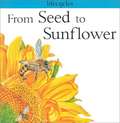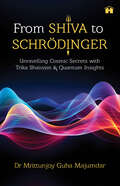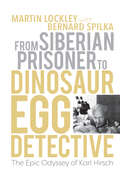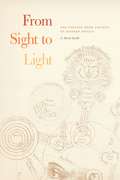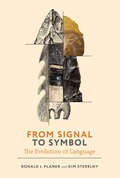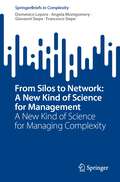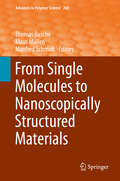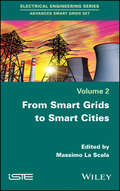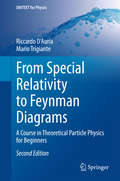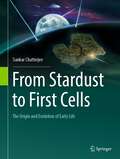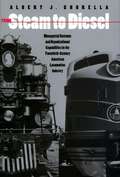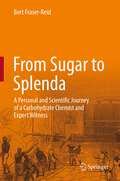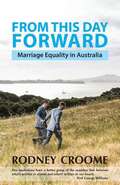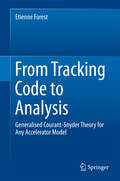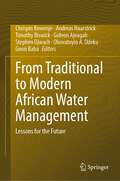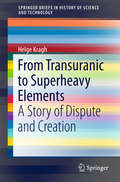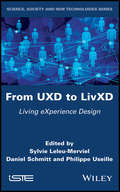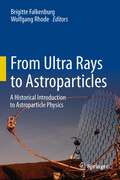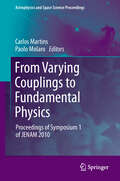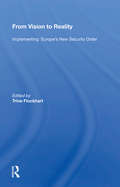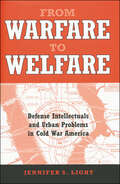- Table View
- List View
From Seed to Sunflower
by Dr Gerald LeggThis basic introduction uses the example of a sunflower to describe the year-long process by which a seed becomes a plant that can grow seeds of its own. Though the illustrations often employ interesting perspectives, their tones are unappealing garish. Brief Sunflower Facts and a growth time line are appended.
From Shiva to Schrödinger
by Mrittunjoy Guha MajumdarFrom Shiva to Schrödinger offers a revelatory journey into the teachings of Trika Shaivism and their remarkable alignment with the discoveries of modern quantum physics. This thought-provoking book demonstrates how the profound insights of this ancient spiritual tradition predate and parallel the concepts emerging from the cutting-edge world of quantum mechanics.With clarity and depth, the author illustrates how the Trika Shaivism philosophy anticipated many of the important discoveries that modern physicists are just beginning to comprehend. He delves into the heart of both ancient spirituality and contemporary science to showcase how concepts like non-duality, the interconnectedness of all existence, and the illusion of separation resonate powerfully with the latest scientific theories of entanglement, quantum superposition, and the observer effect.All in all, From Shiva to Schrödinger is not just a bridge between ancient wisdom and contemporary insights; it is a beacon illuminating the path to a deeper understanding of our universe and ourselves. So, whether you are drawn to spiritual inquiry or scientific discovery, this book offers a transformative perspective that will enrich your contemporary quest for knowledge.
From Siberian Prisoner to Dinosaur Egg Detective: The Epic Odyssey of Karl Hirsch (Life of the Past)
by Martin LockleyThe inspiring story of the man who doggedly sought the secrets hidden within dinosaur eggs.From Siberian Prisoner to Dinosaur Egg Detective explores the fascinating story of Karl Franz Hirsch (1921–1996). After serving in the German army in WWII, being wounded and captured by the Soviets in Danzig and then sent to a prisoner of war camp in Siberia, Hirsch went on to become one of the world's leading experts on fossil eggs. After starting a new life in Colorado, Hirsch became an avid fossil hunter and one day discovered by accident a dinosaur egg. Armed with curiosity and a microscope, he began to study it. In 1979, at the age of 58, Hirsch published his first scientific paper on fossil eggs. Hirsch went on to write dozens of influential technical papers and collaborate with professional paleontologists at the University of Colorado Boulder and elsewhere. At his death, his immense research collection consisted of 35,000 photographs, 20,000 pages of notes, and 3000 fossil egg specimens. From Siberian Prisoner to Dinosaur Egg Detective presents Hirsch's inspiring life story, demonstrating how brilliance and determination are key ingredients in the advancement of scientific understanding.
From Sight to Light: The Passage from Ancient to Modern Optics
by A. Mark SmithFrom its inception in Greek antiquity, the science of optics was aimed primarily at explaining sight and accounting for why things look as they do. By the end of the seventeenth century, however, the analytic focus of optics had shifted to light: its fundamental properties and such physical behaviors as reflection, refraction, and diffraction. This dramatic shift—which A. Mark Smith characterizes as the “Keplerian turn”—lies at the heart of this fascinating and pioneering study. Breaking from previous scholarship that sees Johannes Kepler as the culmination of a long-evolving optical tradition that traced back to Greek antiquity via the Muslim Middle Ages, Smith presents Kepler instead as marking a rupture with this tradition, arguing that his theory of retinal imaging, which was published in 1604, was instrumental in prompting the turn from sight to light. Kepler’s new theory of sight, Smith reveals, thus takes on true historical significance: by treating the eye as a mere light-focusing device rather than an image-producing instrument—as traditionally understood—Kepler’s account of retinal imaging helped spur the shift in analytic focus that eventually led to modern optics. A sweeping survey, From Sight to Light is poised to become the standard reference for historians of optics as well as those interested more broadly in the history of science, the history of art, and cultural and intellectual history.
From Signal to Symbol: The Evolution of Language (Life and Mind: Philosophical Issues in Biology and Psychology)
by Kim Sterelny Ronald PlanerA novel account of the evolution of language and the cognitive capacities on which language depends.In From Signal to Symbol, Ronald Planer and Kim Sterelny propose a novel theory of language: that modern language is the product of a long series of increasingly rich protolanguages evolving over the last two million years. Arguing that language and cognition coevolved, they give a central role to archaeological evidence and attempt to infer cognitive capacities on the basis of that evidence, which they link in turn to communicative capacities. Countering other accounts, which move directly from archaeological traces to language, Planer and Sterelny show that rudimentary forms of many of the elements on which language depends can be found in the great apes and were part of the equipment of the earliest species in our lineage. After outlining the constraints a theory of the evolution of language should satisfy and filling in the details of their model, they take up the evolution of words, composite utterances, and hierarchical structure. They consider the transition from a predominantly gestural to a predominantly vocal form of language and discuss the economic and social factors that led to language. Finally, they evaluate their theory in terms of the constraints previously laid out.
From Signals to Image: A Basic Course on Medical Imaging for Engineers
by Haim Azhari John A. Kennedy Noam Weiss Lana VolokhThis textbook, intended for advanced undergraduate and graduate students, is an introduction to the physical and mathematical principles used in clinical medical imaging. The first two chapters introduce basic concepts and useful terms used in medical imaging and the tools implemented in image reconstruction, while the following chapters cover an array of topics such as: physics of x-rays and their implementation in planar and computed tomography (CT) imaging;nuclear medicine imaging and the methods of forming functional planar and single photon emission computed tomography (SPECT) images and Clinical imaging using positron emitters as radiotracers. The book also discusses the principles of MRI pulse sequencing and signal generation, gradient fields, and the methodologies implemented for image formation, form flow imaging and magnetic resonance angiography and the basic physics of acoustic waves, the different acquisition modes used in medical ultrasound, and the methodologies implemented for image formation and for flow imaging using the Doppler Effect.By the end of the book, readers will know what is expected from a medical image, will comprehend the issues involved in producing and assessing the quality of a medical image, will be able to conceptually implement this knowledge in the development of a new imaging modality, and will be able to write basic algorithms for image reconstruction. Knowledge of calculus, linear algebra, regular and partial differential equations, and a familiarity with the Fourier transform and it applications is expected, along with fluency with computer programming. The book contains exercises, homework problems, and sample exam questions that are exemplary of the main concepts and formulae students would encounter in a clinical setting.
From Silos to Network: A New Kind of Science for Managing Complexity (SpringerBriefs in Complexity)
by Domenico Lepore Angela Montgomery Giovanni Siepe Francesco SiepeThis book provides the conceptual framework and a comprehensive guide to the principles, methods and tools for managing organizations. The authors introduce “New Knowledge” by presenting a methodology, 'The Decalogue’, that portrays a genuinely systemic approach for managing complexity in organizations and Value Chains through focusing on the management of a leverage point called constraint (Theory of Constraints) and the understanding of variation (Theory of Profound Knowledge). This systemic approach leverages the intrinsic process and project-based nature of the work of organizations. Functional hierarchy is replaced by a network-like structure, driven by the goal of the system and governed by a new design of the organization called “Network of Projects”. The transition towards the Network of Projects requires a cognitive shift in the way we view and put to good use human talent and ingenuity as well as a powerful algorithm to orchestrate and synchronize individual competencies.The authors discuss at length this algorithm, how the Theory of Constraints helps in the cognitive challenges of this shift and also how technology can be used fruitfully to assist with the operational implications. The target audience for this book is made up of leaders and managers of organizations as well as researchers and practitioners in the field of management and organizational design.
From Single Molecules to Nanoscopically Structured Materials
by Thomas Basché Klaus Müllen Manfred SchmidtMechanical Properties of Single Molecules and Polymer Aggregates Rüdiger Berger, Kurt Binder, Gregor Diezemann, Jürgen Gauß, Mark Helm, Katharina Landfester, Wolfgang Paul (Halle), Peter Virnau. Optical Properties of Individual Molecular Aggregates and Nano Particles Thomas Basché, Hans-Jürgen Butt, Gregor Diezemann, Jürgen Gauß, Klaus Müllen, Harald Paulsen, Carsten Sönnichsen, Rudolf Zentel. Structure Formation of Polymeric Building Blocks I: Self-assembly of Copolymers Kurt Binder, Holger Frey, Andreas Kilbinger (Univ. Fribourg), Ute Kolb, Michael Maskos (IMM Mainz), Wolfgang Paul (Univ. Halle), Hans Wolfgang Spiess. Structure Formation of Polymeric Building Blocks II: Complex Polymer Architectures Kurt Binder, Hans Jürgen Butt, Angelika Kühnle, Klaus Müllen, Wolfgang Paul (Univ. Halle), Erwin Schmidt, Manfred Schmidt, Hans Wolfgang Spiess, Thomas Vilgis. Structure Formation of Polymeric Building Blocks III: Polymer Complexes in Biological Applications Kurt Kremer, Heiko Luhmann, Christine Peter, Friederike Schmid, Erwin Schmidt, Manfred Schmidt, Eva Sinner (Univ. of Natural Resources, Vienna), Tanja Weil (Univ. Ulm).
From Smart Grids to Smart Cities: New Challenges in Optimizing Energy Grids
by Carlo Alberto Nucci Massimo La Scala S. Lamonaca Sergio Bruno Ugo StecchiThis book addresses different algorithms and applications based on the theory of multiobjective goal attainment optimization. In detail the authors show as the optimal asset of the energy hubs network which (i) meets the loads, (ii) minimizes the energy costs and (iii) assures a robust and reliable operation of the multicarrier energy network can be formalized by a nonlinear constrained multiobjective optimization problem. Since these design objectives conflict with each other, the solution of such the optimal energy flow problem hasn’t got a unique solution and a suitable trade off between the objectives should be identified. A further contribution of the book consists in presenting real-world applications and results of the proposed methodologies developed by the authors in three research projects recently completed and characterized by actual implementation under an overall budget of about 23 million €.
From Snorkelers to Scuba Divers in the Elementary Science Classroom: Strategies and Lessons That Move Students Toward Deeper Learning
by John T. Almarode Ann M. MillerInspire a deep and lasting love of science in young students The way students view scientific knowledge is largely dependent on their early experiences with science instruction. With so much attention paid to student performance relative to the rest of the world, it is imperative for science teachers to engage elementary learners in ways that foster prolonged interest, deep conceptual understanding, and success in middle and high school as well as beyond. Combining the latest findings in the science of learning with student- and teacher-tested techniques, From Snorkelers to Scuba Divers provides the framework essential for encouraging students to shed their snorkels and plunge into the world of science. Readers will find: Evidence-based, research-driven strategies that encourage both deep thinking and conceptual understanding Classroom examples that demonstrate each aspect of the standards-based instructional framework in action Professional development tasks that provide teachers with support in implementing strategies for students at all levels, from surface to deep This teacher-friendly resource is invaluable for preparing learners to approach science with creativity, confidence, and insight.
From Snorkelers to Scuba Divers in the Elementary Science Classroom: Strategies and Lessons That Move Students Toward Deeper Learning
by John T. Almarode Ann M. MillerInspire a deep and lasting love of science in young students The way students view scientific knowledge is largely dependent on their early experiences with science instruction. With so much attention paid to student performance relative to the rest of the world, it is imperative for science teachers to engage elementary learners in ways that foster prolonged interest, deep conceptual understanding, and success in middle and high school as well as beyond. Combining the latest findings in the science of learning with student- and teacher-tested techniques, From Snorkelers to Scuba Divers provides the framework essential for encouraging students to shed their snorkels and plunge into the world of science. Readers will find: Evidence-based, research-driven strategies that encourage both deep thinking and conceptual understanding Classroom examples that demonstrate each aspect of the standards-based instructional framework in action Professional development tasks that provide teachers with support in implementing strategies for students at all levels, from surface to deep This teacher-friendly resource is invaluable for preparing learners to approach science with creativity, confidence, and insight.
From Special Relativity to Feynman Diagrams
by Riccardo D'Auria Mario TrigianteThis book, now in its second edition, provides an introductory course on theoretical particle physics with the aim of filling the gap that exists between basic courses of classical and quantum mechanics and advanced courses of (relativistic) quantum mechanics and field theory. After a concise but comprehensive introduction to special relativity, key aspects of relativistic dynamics are covered and some elementary concepts of general relativity introduced. Basics of the theory of groups and Lie algebras are explained, with discussion of the group of rotations and the Lorentz and Poincaré groups. In addition, a concise account of representation theory and of tensor calculus is provided. Quantization of the electromagnetic field in the radiation range is fully discussed. The essentials of the Lagrangian and Hamiltonian formalisms are reviewed, proceeding from systems with a finite number of degrees of freedom and extending the discussion to fields. The final four chapters are devoted to development of the quantum field theory, ultimately introducing the graphical description of interaction processes by means of Feynman diagrams. The book will be of value for students seeking to understand the main concepts that form the basis of contemporary theoretical particle physics and also for engineers and lecturers. An Appendix on some special relativity effects is added.
From Stardust to First Cells: The Origin and Evolution of Early Life
by Sankar ChatterjeeThis book presents a groundbreaking hypothesis to answer one of the greatest scientific mysteries: How did life begin? Like a detective piecing together seemingly disparate bits of evidence, Dr. Sankar Chatterjee combines the most recent discoveries in cosmology, geology, chemistry, information systems, and biology, weaving a vast tapestry from the threads of current research. Dr. Chatterjee convincingly argues that the odyssey of life first began when the fundamental building blocks were brought to Earth by meteorites. These cosmic compounds concentrated and simmered like a soup in hydrothermal crater-caldrons. Through a system of subterranean vent networks, a biosynthetic-rich variety of organic compounds mixed and matched into a recipe of rich biomolecules guided by prebiotic information systems. Through symbiosis, these complex biopolymers gradually assemble into membrane-bound protocells. At each stage of this evolutionary progression, through natural selection, they refined with increasing stability and complexity, ultimately leading to the emergence of the first cells about four billion years ago. In this book, Dr. Chatterjee tells this story in rigorous detail in language that is both accessible and engaging.
From Steam to Diesel: Managerial Customs and Organizational Capabilities in the Twentieth-Century American Locomotive Industry (Princeton Studies in Business and Technology)
by Albert ChurellaThis overview of the leading locomotive producers in the United States during the twentieth century shows how they responded to a radical technological change: the replacement of steam locomotives by diesels. The locomotive industry provides a valuable case study of business practices and dramatic shifts in innovation patterns, since two companies--General Motors and General Electric--that had no traditional ties to locomotive production demolished established steam locomotive manufacturers. Albert Churella uses many previously untapped sources to illustrate how producers responded to technological change, particularly between the 1920s and the 1960s. Companies discussed include the American Locomotive Company (ALCo), the Baldwin Locomotive Works, the Lima Locomotive Works, Fairbanks-Morse, the Electro-Motive Division of General Motors, and General Electric.A comparative work of business history and the history of technology, the book is not a complete history of any locomotive builder, nor does it explore the origins of the diesel engine in great detail. What it does, and does superbly, is to demonstrate how managers addressed radical shifts in technology and production methods. Churella reveals that managerial culture and corporate organizational routines, more than technological competency per se, allowed some companies to succeed, yet constrained the actions of others. He details the shift from small-batch custom manufacturing techniques in the steam locomotive industry to mass-production methods in the diesel locomotive industry. He also explains that chance events and fortuitous technological linkages helped to shape competitive patterns in the locomotive industry.
From Sugar to Splenda
by Bert Fraser-ReidMore than just coincidence connects a Tate & Lyle lawsuit and artificial sweetener to Jamaican-born Chemist Bert Fraser-Reid. From his first experience of Chemistry through his diabetic father, to his determination and drive as a Chemistry student in Canada, Fraser-Reid weaves a remarkable tale integrating science, law and autobiographical anecdotes. This book arises from the lawsuit brought by Tate & Lyle against companies accused of infringing its patents for sucralose, the sweet ingredient in the artificial sweetener SPLENDA which is made by chlorinating sugar. From a 1958 undergraduate intern witnessing the pioneering experiments on sugar chlorination, to being the 1991 recipient of the world's premiere prize for carbohydrate chemistry, Fraser-Reid was groomed for his role as expert witness in the mentioned lawsuit. Nevertheless, it seems more than his career links Fraser-Reid to the case.
From This Day Forward: Marriage Equality in Australia
by Rodney CroomeAustralia is now the only developed English-speaking country where same-sex couples can't marry. In this timely book, one of Australia's leading marriage equality advocates goes beyond the slogans and sound bites to explain why the nation is debating marriage equality, why the reform matters and how reform can be achieved. Along the way he considers the history of freedom to marry in Australia, what debate on marriage equality reveals about his home state of Tasmania, and how gay identity and marriage have evolved to the point where marriage equality is not only possible but likely.
From Tracking Code to Analysis
by Etienne ForestThis book illustrates a theory well suited to tracking codes, which the author has developed over the years. Tracking codes now play a central role in the design and operation of particle accelerators. The theory is fully explained step by step with equations and actual codes that the reader can compile and run with freely available compilers. In this book, the author pursues a detailed approach based on finite "s"-maps, since this is more natural as long as tracking codes remain at the center of accelerator design. The hierarchical nature of software imposes a hierarchy that puts map-based perturbation theory above any other methods. This is not a personal choice: it follows logically from tracking codes overloaded with a truncated power series algebra package. After defining abstractly and briefly what a tracking code is, the author illustrates most of the accelerator perturbation theory using an actual code: PTC. This book may seem like a manual for PTC; however, the reader is encouraged to explore other tools as well. The presence of an actual code ensures that readers will have a tool with which they can test their understanding. Codes and examples will be available from various sites since PTC is in MAD-X (CERN) and BMAD (Cornell).
From Traditional to Modern African Water Management: Lessons for the Future
by Andreas Haarstrick Chrispin Kowenje Timothy Biswick Gideon Ajeagah Stephen Ojwach Oluwatoyin A. Odeku Gnon BabaThis book preserves and scientifically interprets the African foreknowledge on water resources management. It offers insight into the relevance of the traditional knowledge and practices to modern approaches on sustainable water management. The African continent has partially preserved its natural habitat for centuries. In this book, this knowledge is combined with the current scientific understanding. The traditional practices are categorized as: i) water harvesting, ii) water transportation, iii) water storage and conservation, iv) water treatments, v) myths and folk stories about water management or conservation, vi) water resource management systems, and vii) soil–water–forest conservation/management systems sub-topics. The findings presented here are in line with SDG 6, which aims at ensuring availability and sustainable management of water and sanitation for all by the year 2030.
From Transuranic to Superheavy Elements
by Helge KraghThe story of superheavy elements - those at the very end of the periodic table - is not well known outside the community of heavy-ion physicists and nuclear chemists. But it is a most interesting story which deserves to be known also to historians, philosophers, and sociologists of science and indeed to the general public. This is what the present work aims at. It tells the story or rather parts of the story, of how physicists and chemists created elements heavier than uranium or searched for them in nature. And it does so with an emphasis on the frequent discovery and naming disputes concerning the synthesis of very heavy elements. Moreover, it calls attention to the criteria which scientists have adopted for what it means to have discovered a new element. In this branch of modern science it may be more appropriate to speak of creation instead of discovery. The work will be of interest to scientists as well as to scholars studying modern science from a meta-perspective.
From UXD to LivXD: Living eXperience Design
by Daniel Schmitt Sylvie Leleu-Merviel Philippe UseilleLiving eXperience Design – the design of life experiences – is an extension of user experience design (UXD). The context comprises usage and practice in real contexts in which spatial, urban, social, temporal, historical and legal dimensions are considered. Reflecting upon LivXD is to examine the whole experience of a target audience in a variety of situations – and not only in those involving digital technology. This book begins with the definition of LivXD and its associated epistemology, and proceeds to detail field experiments in certain privileged areas: the relation to creation and works, mediation and adult education.
From Ultra Rays to Astroparticles
by Brigitte Falkenburg Wolfgang RhodeThe scope of the book is to give an overview of the history of astroparticle physics, starting with the discovery of cosmic rays (Victor Hess, 1912) and its background (X-ray, radioactivity). The book focusses on the ways in which physics changes in the course of this history. The following changes run parallel, overlap, and/or interact: - Discovery of effects like X-rays, radioactivity, cosmic rays, new particles but also progress through non-discoveries (monopoles) etc. - The change of the description of nature in physics, as consequence of new theoretical questions at the beginning of the 20th century, giving rise to quantum physics, relativity, etc. - The change of experimental methods, cooperations, disciplinary divisions. With regard to the latter change, a main topic of the book is to make the specific multi-diciplinary features of astroparticle physics clear.
From Varying Couplings to Fundamental Physics
by Carlos Martins Paolo MolaroNature is characterized by a number of physical laws and fundamental dimensionless couplings. These determine the properties of our physical universe, from the size of atoms, cells and mountains to the ultimate fate of the universe as a whole. Yet it is rather remarkable how little we know about them. The constancy of physical laws is one of the cornerstones of the scientific research method, but for fundamental couplings this is an assumption with no other justification than a historical assumption. There is no 'theory of constants' describing their role in the underlying theories and how they relate to one another or how many of them are truly fundamental. Studying the behaviour of these quantities throughout the history of the universe is an effective way to probe fundamental physics. This explains why the ESA and ESO include varying fundamental constants among their key science drivers for the next generation of facilities. This symposium discussed the state-of-the-art in the field, as well as the key developments anticipated for the coming years.
From Vision To Reality: Implementing Europe's New Security Order
by Trine FlockhartFrom Vision to Reality takes the reader past the fixation with political decision-making by focusing on the process of implementation that follows important policy decisions. The book identifies the intentions behind a collection of key policy decisions for establishing Europe's new security order and investigates whether the implementation of thos
From Warfare to Welfare: Defense Intellectuals and Urban Problems in Cold War America
by Jennifer S. LightDuring the early decades of the Cold War, large-scale investments in American defense and aerospace research and development spawned a variety of problem-solving techniques, technologies, and institutions. From systems analysis to reconnaissance satellites to think tanks, these innovations did not remain exclusive accessories of the defense establishment. Instead, they readily found civilian applications in both the private and public sector. City planning and management were no exception.Jennifer Light argues that the technologies and values of the Cold War fundamentally shaped the history of postwar urban America. From Warfare to Welfare documents how American intellectuals, city leaders, and the federal government chose to attack problems in the nation's cities by borrowing techniques and technologies first designed for military engagement with foreign enemies. Experiments in urban problem solving adapted the expertise of defense professionals to face new threats: urban chaos, blight, and social unrest. Tracing the transfer of innovations from military to city planning and management, Light reveals how a continuing source of inspiration for American city administrators lay in the nation's preparations for war.

